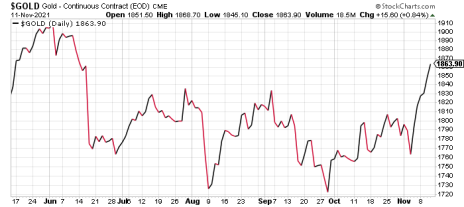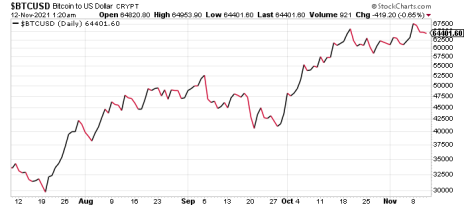A debate has emerged between gold bugs and bitcoin enthusiasts over which asset offers the most portfolio protection from economic uncertainty.
Gold lovers insist the yellow metal’s long-term history of maintaining its value relative to inflation is proof of its superior asset protection power. Bitcoin believers, meanwhile, assert that crypto offers equal or better protection against uncertain times due, in part, to its ease of storage and transfer compared to gold.




Both arguments have some merit, and it’s certain that bitcoin will play an increasingly important role in asset protection and diversification. But it’s my contention that gold will continue to be regarded as the better safe haven of the two whenever market participants are seriously worried about the investing outlook.
Gold and Bitcoin: The Charts
The suggestion that gold has been replaced by bitcoin as the investing world’s preferred safe haven is even now being put to the test. With inflation fears and other global worries abounding, the yellow metal has seen a notable uptick in interest in just the last few weeks. Indeed, since bottoming around $1,725 an ounce on September 29, the metal has risen 8% for its best performance of the last six months.
Gold is known for being a stodgy performer, so 8% may not seem all that impressive compared to faster-moving assets like stocks and cryptocurrencies. Bitcoin, for instance, has risen by an eye-popping 56% in the last six weeks. Studies show that bitcoin tends to drastically outperform gold when the economic outlook is stable and investors are in a speculative mood.
Where gold comes into its own, however, is during times when investors are fraught with fear. Such was the case during the stormy period in the fourth quarter of 2018, when the U.S.-China trade war was at its height and investors were profoundly worried about the global economy’s health. During the last three months of that year, the S&P 500 Index lost 20%, while bitcoin was down by an even more troubling 40%. Gold, by contrast, was up almost 10% as investors flocked to the metal to ride out the storm.
During last year’s credit crash, gold also outshined other assets with a 13% gain during the fearsome February-March period, while the S&P plunged 35% and bitcoin collapsed 62%. Clearly, gold’s best performances occur during major bouts of global market volatility, while bitcoin’s strongest showings occur against a backdrop of falling risk aversion.
For much of this year, gold has been asleep while stocks and cryptos have outperformed in an environment marked by diminishing Covid fears and higher risk taking. More recently, however, fears are mounting over inflation pressures. Investors are worried that increasing U.S. wholesale prices—which rose 9% in October to their highest annual increase on record—might persist longer than many expected.
Then there’s China, whose economy is growing at its slowest pace in a year as the energy crisis and supply-chain disruptions slow the pace of that nation’s industrial output. Another problem is inflation, as China’s Producer Price Index surged 14% in October to a record. Its Consumer Price Index rose nearly 2% in October from a year ago—double the rate of the previous month and the fastest pace since September 2020, according to CNN.
Additionally, investors are worried after the Federal Reserve warned that China’s real estate troubles could spill over into the U.S. China’s largest property developer, Evergrande, is struggling to avoid default even as other Chinese real estate developers also face debt issues. Gold’s bullish reaction to the Fed’s warning suggests the metal’s “fear factor” is once again in play.
Gold should remain strong as long as global concerns persist, since investors will almost certainly look to hedge against another potential bout of market jitters. And while it’s possible bitcoin prices could also remain firm in the face of these worries, recent history suggests that gold will outperform the cryptocurrency if the climate of fear accelerates.
Should You Own Both?
In the final analysis, both gold and bitcoin have their rightful places in a well-diversified portfolio. Just remember that each asset has its own unique behavioral characteristics that are largely dependent on the prevailing economic and financial market climate. Accordingly, adjustments can be made to the amount of each asset you hold based on whether risk aversion (fear) or risk embracement (greed) is dominant.
If you want even more ideas for the best performing precious and industrial metals and mining stocks and ETFs right now, please consider subscribing to my Sector Xpress Gold & Metals Advisor. In each issue, I provide you with some of the market’s strongest metals and mining stocks/ETFs from both a technical and a fundamental perspective.
Do you have exposure to either gold or bitcoin in your portfolio? Tell us about it in the comments below.






